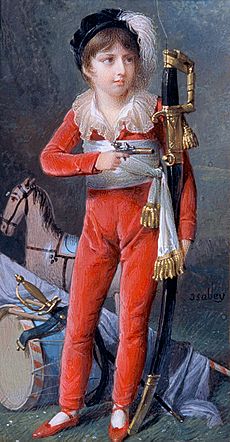Oscar I of Sweden facts for kids
Quick facts for kids Oscar I |
|
|---|---|
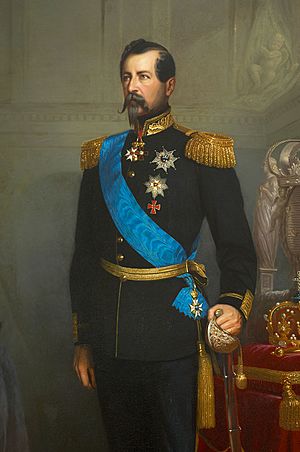
Portrait by Arvid Julius Gottfried Virgin, 1858
|
|
| King of Sweden and Norway | |
| Reign | 8 March 1844 – 8 July 1859 |
| Coronation | 28 September 1844, Stockholm |
| Predecessor | Charles XIV & III John |
| Successor | Charles XV & IV |
| Born | Joseph François Oscar Bernadotte 4 July 1799 Paris, French First Republic |
| Died | 8 July 1859 (aged 60) Stockholm, Sweden |
| Burial | 8 August 1859 Riddarholm Church |
| Spouse |
Josephine of Leuchtenberg
(m. 1823) |
| Issue |
|
| House | Bernadotte |
| Father | Charles XIV John |
| Mother | Désirée Clary |
| Religion | Church of Sweden prev. Catholic Church |
Oscar I (born Joseph François Oscar Bernadotte; 4 July 1799 – 8 July 1859) was the King of Sweden and Norway. He ruled from 8 March 1844 until his death. He was the second king from the House of Bernadotte family.
Oscar was the only child of King Charles XIV John. He became king after his father passed away. During his time as king, he brought many new ideas and changes. He worked to make Sweden and Norway closer. In 1857, the Swedish Parliament, called the Riksdag, said that he had made the country more successful than any king before him.
Contents
Oscar's Early Life
Oscar was born in Paris, France. His father was Jean-Baptiste Jules Bernadotte, who was a French general. His mother was Désirée Clary. She was once engaged to Napoleon Bonaparte.
Oscar was named Joseph after his godfather, Joseph Bonaparte. He also received the names François Oscar. Napoleon chose the name Oscar from old poems. This name became the one his family used most often. Oscar spent his first years in France with his mother and aunt. He started learning from a teacher named Le Moine in 1807.
Becoming a Prince of Sweden
In 1810, the Swedish king, Charles XIII, had no children to take his place. So, Oscar's father was suggested as a possible new heir. One reason for choosing his father was that he already had a son, Oscar. This meant the future of the royal family would be secure.
On 21 August 1810, the Swedish Parliament chose Oscar's father to be the next king. Two months later, Oscar's father was officially adopted by the king. He took the name "Charles John." Oscar then became a Prince of Sweden. He was also given the title of Duke of Södermanland.
Oscar and his mother moved to Stockholm, Sweden, in June 1811. Oscar quickly got used to life at the royal court. He learned the Swedish language very fast. However, his mother found it hard to adjust to the cold weather. She left Sweden in the summer of 1811 and did not return until 1823. Oscar had a Swedish teacher and soon could help his father by translating. In 1818, he became the head of Uppsala University.
Oscar became the Crown Prince in 1818. This happened when his adoptive grandfather passed away. His father, Charles John, then became King of Sweden and Norway.
Marriage and Family
To make the new Bernadotte royal family stronger, King Charles XIV John looked for a princess for Oscar to marry. He considered four princesses. Oscar eventually married Josephine of Leuchtenberg. She was the granddaughter of Empress Josephine.
They were married in Munich on 22 May 1823. A second wedding ceremony took place in Stockholm on 19 June 1823.
Oscar and Josephine had five children:
- King Charles XV & IV (1826–1872)
- Prince Gustaf, Duke of Uppland (1827–1852)
- King Oscar II (1829–1907)
- Princess Eugenie (1830–1889)
- Prince August, Duke of Dalarna (1831–1873)
Crown Prince's Work
As Crown Prince, Oscar served as the leader of Norway for short periods in 1824 and 1833. He also had many interests. From 1832 to 1834, he finished a romantic opera called Ryno, the errant knight. A young composer had left it unfinished.
In 1839, Oscar wrote articles about public education. In 1841, he wrote a book about prison reforms. He published this book without using his name.
Oscar's Reign as King
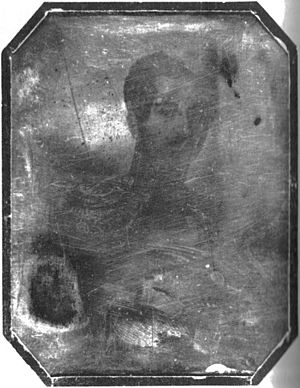
When Oscar became king in 1844, many people hoped he would bring big changes. He was known for having more modern ideas than his father. One of the first things he did was to allow more freedom of the press. This meant people could write and publish more freely.
In 1845, he passed an important law. It said that brothers and sisters should inherit equally if there was no will. This was a big step towards gender equality in Sweden. King Oscar I also made Sweden and Norway more equal. He introduced new flags and a new coat of arms for their union.
In foreign matters, Oscar I believed in the idea of different nations being strong. In 1848, he helped Denmark against Prussia in a war. He sent Swedish and Norwegian soldiers to help. He also helped to arrange a peace agreement in 1848. He was one of the people who promised to protect Denmark's independence in 1852.
By 1850, Oscar I wanted to unite the three Scandinavian countries. But this plan did not work out. He did manage to change his father's policy towards Russia. He was worried Russia might try to take land near Norway. So, he stayed neutral during the Crimean War. Later, he made an agreement with Great Britain and France in 1855. This agreement helped protect Sweden and Norway's land.
Later Years and Death
In the 1850s, King Oscar's health started to get worse. By 1857, he became paralyzed. He passed away two years later, on 8 July 1859, at the Royal Palace in Stockholm. He was buried in the Riddarholmen Church. This church is the traditional burial place for Swedish kings. His oldest son, Charles XV, became the next king.
Honours and Awards
Oscar I received many honours and awards during his life. These were from both Sweden and Norway, and from other countries around the world.
Swedish and Norwegian honours
- Knight and Commander of the Order of the Seraphim, 26 September 1810
- Knight of the Order of Charles XIII, 26 September 1810
- Commander Grand Cross of the Order of the Sword, 26 September 1810
- Commander Grand Cross of the Order of the Polar Star, 26 September 1810
- Commander Grand Cross of the Order of Vasa, 26 September 1810
- Founder and Master of the Royal Norwegian Order of St. Olav, 21 August 1847
Foreign honours
 Kingdom of Prussia: Knight of the Order of the Black Eagle, 27 August 1811
Kingdom of Prussia: Knight of the Order of the Black Eagle, 27 August 1811 Russian Empire:
Russian Empire:
- Knight of the Order of St. Andrew, 30 August 1812
- Knight of the Order of St. Alexander Nevsky, 30 August 1812
 Denmark: Knight of the Order of the Elephant, 1 December 1835
Denmark: Knight of the Order of the Elephant, 1 December 1835 Spain: Knight of the Order of the Golden Fleece, 15 June 1844
Spain: Knight of the Order of the Golden Fleece, 15 June 1844 Kingdom of Bavaria: Knight of the Order of St. Hubert, 1844
Kingdom of Bavaria: Knight of the Order of St. Hubert, 1844 Hohenzollern: Cross of Honour of the Princely House Order of Hohenzollern, 1st Class
Hohenzollern: Cross of Honour of the Princely House Order of Hohenzollern, 1st Class Baden:
Baden:
- Knight of the House Order of Fidelity, 1845
- Knight Grand Cross of the Order of the Zähringer Lion, 1845
 Empire of Brazil:
Empire of Brazil:
- Knight Grand Cross of the Order of the Southern Cross
- Knight Grand Cross of the Order of the Rose
 Netherlands: Knight Grand Cross of the Military William Order, 21 June 1849
Netherlands: Knight Grand Cross of the Military William Order, 21 June 1849 Belgium: Grand Cordon of the Order of Leopold (military), 20 October 1849
Belgium: Grand Cordon of the Order of Leopold (military), 20 October 1849 Kingdom of Hanover:
Kingdom of Hanover:
- Knight of the Order of St. George, 1849
- Knight Grand Cross of the Royal Guelphic Order
 Austrian Empire: Knight Grand Cross of the Order of St. Stephen, 1850
Austrian Empire: Knight Grand Cross of the Order of St. Stephen, 1850 Nassau: Knight of the Order of the Gold Lion of Nassau, July 1858
Nassau: Knight of the Order of the Gold Lion of Nassau, July 1858
Royal Symbols
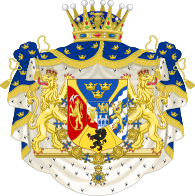 Crown Prince, Duke of Södermanland (1818–1826) |
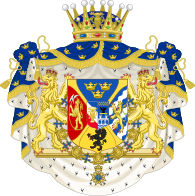 Crown Prince, Duke of Södermanland (1826–1844) |
 King Oscar I of Sweden and Norway |
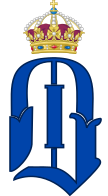 Royal Monogram of King Oscar I of Sweden |
See also
 In Spanish: Óscar I de Suecia para niños
In Spanish: Óscar I de Suecia para niños


